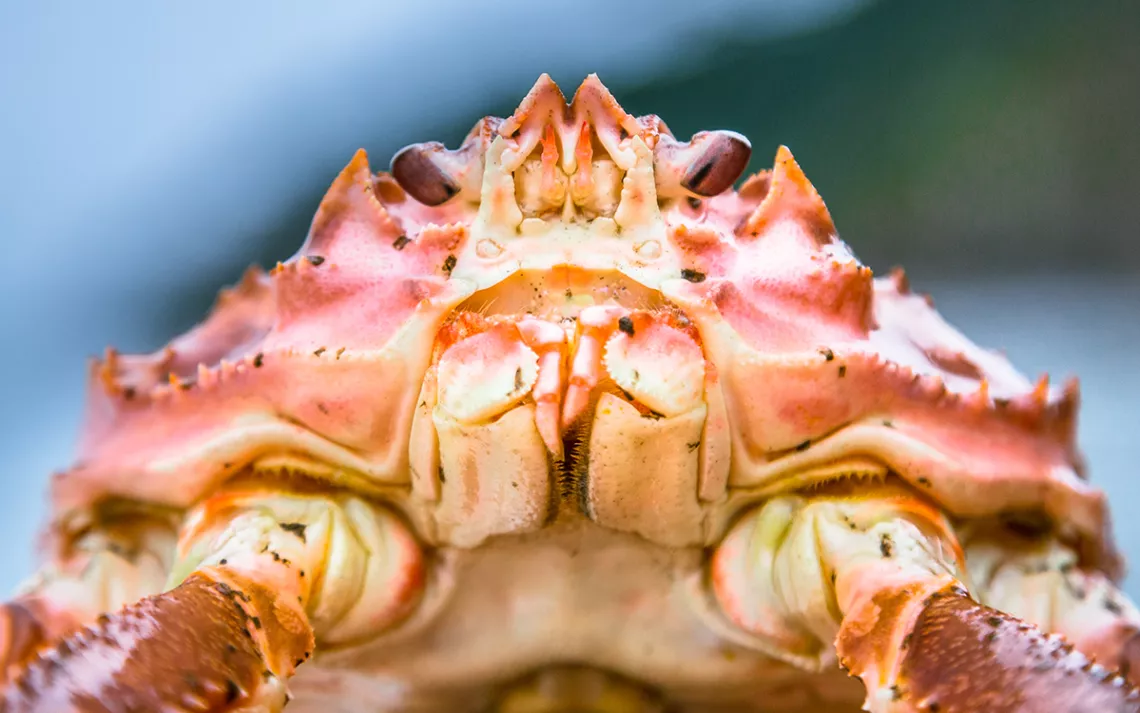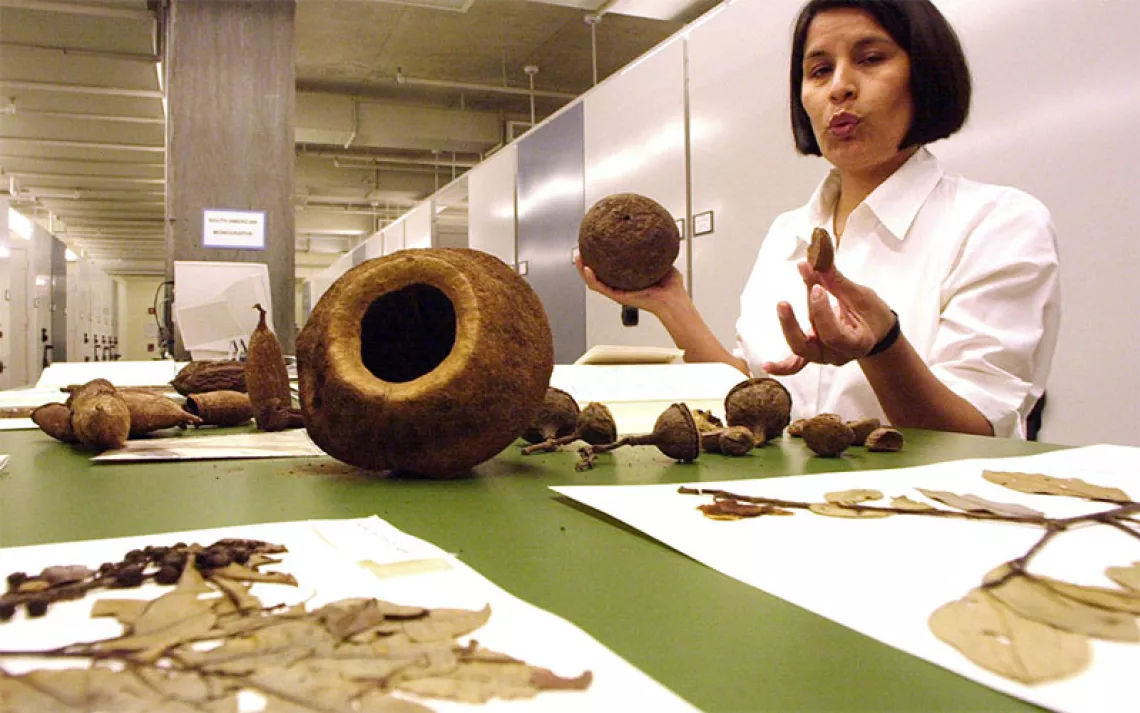The Mystery of the Missing Crabs
Whither Alaska’s 7 billion snow crabs? Can we blame climate change?

Head of a snow crab. | Photo by Gfed/iStock
Earlier this month, Alaska officials canceled the winter snow crab harvest—for the first time in history—on the grounds that at least 7 billion snow crabs are missing. According to the Alaska Department of Fish and Game, the snow crab population in Bristol Bay (a.k.a. crab Manhattan) shrank from around 8 billion in 2018 to 1 billion in 2021.
This is terrible news for anyone who likes to eat crab, anyone who makes money off of crab fishing (less than a decade ago, the gross revenue from the crab harvest was about $280 million), or anyone who aspires to keep wild ecosystems thriving and healthy.
More important, where did the crabs go? Whodunit?
Here are a few theories:
Cod ate them
For years, fishing vessels working in the Bering Sea have been noticing a whole lot of cod, and a whole lot less crab. When they did find crab, they often found it inside of cod. “The fish we are catching now are just beautiful. They are big and healthy,” Scott Hanson, a fishing boat captain, told the Seattle Times in 2019. “I’ve found their stomachs stuffed with hard-shelled crab legs.”
Snow crabs have historically mitigated the risk posed by their deliciousness by laying their eggs in deposits of marine snow in the dense, cold, salty pools of water that form under melting ice. Now that those waters are warming, cod and pollack, which have migrated hundreds of miles northward since the 1970s, are treating this thawing nursery like an all-you-can-eat buffet.
That said, it seems ambitious to assume that cod and pollack alone can wipe out 7 billion crabs, especially since all sizes of snow crabs are missing, not just the younger ones that cod and pollack are most fond of. They may be culprits, but it’s unlikely that they could pull off a job this big.
Warming seas increased their little snow crab metabolisms to the point where they ate each other in a frenzy
“They basically cannibalized each other,” Wes Jones, fisheries, research, and development director for the Norton Sound Economic Development Corporation, told Time in an article with the truly extraordinary title “Crustacean Decimation Due to Climate-Change-Driven Cannibalization.”
It is true that snow crabs do eat each other from time to time. But, as with cod, it’s unlikely they could pull off a job this big. Also: Jones appears to be the only person publicly advancing this theory, which, in the Time interview, he attributed to “scientists.”
Warming sea temperatures made snow crabs vulnerable to parasites and other ailments
Crabs living in warmer waters molt more frequently, which makes them more vulnerable to a dinoflagellate parasite that can spread through the snow crab equivalent of white blood cells, stealing their nutrients and leaving the crab tasting like aspirin.
There’s not much doubt that the Bering Sea is transitioning from an arctic to subarctic climate and “bitter crab syndrome” has become common enough to occur frequently on the agenda of the North Pacific Fishery Management Council’s Crab Plan Team.
But that team has also concluded that the local peaks in bitter crab syndrome don’t match the timeline for snow crab decline. Which means that the dinoflagellates, while bad, have more work to do if they want to make it to public enemy number one.
The snow crabs got sick of the place and migrated elsewhere
If pollock and cod have migrated thousands of miles northward, why can’t snow crabs do the same to get away from them? That’s the idea behind a wildly popular theory that snow crabs are migrating into colder—and quite possibly Russian—waters. "Did they run up north to get that colder water?" Gabriel Prout, who owns a fishing business on Kodiak Island, asked CBS News. "Did they completely cross the border? Did they walk off the continental shelf on the edge there, over the Bering Sea?"
But according to the National Oceanic and Atmospheric Administration, they did not—the agency has found no evidence of northern migration.
They got walloped by deep-sea trawlers
One popular theory has to do with another predatory bottom-feeder that warming arctic waters is bringing closer to the snow crab population: deep-sea fishing vessels trawling for cod and pollack.
When journalist Spencer Roberts looked at data collected by the nonprofit Global Fishing Watch, he found trawlers taking advantage of record sea ice lows in 2020 and spending hundreds of hours crisscrossing areas that would have been inaccessible a decade earlier.
This theory makes the crab harvest ban especially frustrating for some fishing operations—while setting out crab pots is canceled until crab numbers recover, accidentally catching crab while trawling for other things is not. The aforementioned Crab Plan Team did not recommend any new restrictions on trawling, on the grounds that snow crab bycatch brought up by trawlers has declined in recent years and that trawlers have agreed to dump any accidentally caught crabs back into the ocean.
That’s not good enough for crab fishing operations that have doubts as to how many crab are surviving the bycatch process or are being wiped out beneath the surface during the trawling process. Even “midwater” trawling boats, which try not to scrape the ocean floor, make contact with the seabed between 40 and 80 percent of their time fishing.
If the crab harvest has crashed because of trawlers dragging nets and chains through previously inaccessible crab nurseries in the search for cod and pollack, the snow crabs may never return unless fishing practices change in the area. Roberts cites the example of the red crab harvest (also canceled this year), which crashed decades ago after trawling rose in the area and which has never recovered to its former levels—possibly because trawlers are still operating in areas where the crabs are known to reproduce.
Will crabs spring eternal?
There is some good news: Snow crabs are extremely good at making more snow crabs.
A single crab can be in possession of 150,000 eggs. Given the right conditions, the estimated 1 billion crabs remaining in the area will flourish, make offspring, and eventually the population will rebound. To do that, though, will take some true crab detective work, to figure out what those right conditions really are.
 The Magazine of The Sierra Club
The Magazine of The Sierra Club



